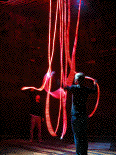
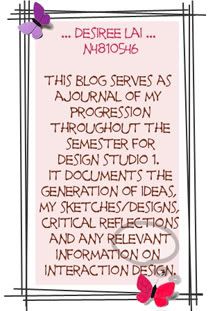
Friday, March 31, 2006
Apart from talking about the artist's intent and application, I did a critique of their work based on the following criteria:
1) Knowledge - Knowledge gained from interacting with exhibit or prior knowledge needed in order to understand it
2) Choice and Control - The level of choice and control the viewers or participants have
3) Conversation - Linking back to the previous entry about Interactivity being a conversation a conversation between two parties; between audience and artwork. They have to participate in this conversation sequence which requires them to listen, think and then speak. Is it better at one aspect such as "speaking" and not good in all?
4) Emotion - Did it manage to evoke a variety of emotions from the audience? If so, what kind of feelings and how?
Conclusion (for essay)
Artist bias would drive them to a certain direction in regards to content and design. Biasness would also affect my personal view and interpretation of their work regarding interactivity and interaction design. Overall, all three exhibits chosen; Gunkulcha (2005), We have you surrounded (2005) and Interstice (2005) had fulfilled its purpose and is deemed as successful designs based on the artist's initial intent. But the limitations of the design would seem more apparent when compared to certain fundamentals of interactivity and other theories of the human cognition. And it is debatable whether such art forms should be designed for the artist or for the user. It isn't always about the artist; but the artists might lose "herself" from her piece that is designed for others. There is no clear 50% division between the two. Therefore, no design is perfect; nothing in this world is completely and utterly flawless.
To read finished essay, go to http://student.ci.qut.edu.au/~n4810546/kib210/kib210ass1.doc
Wednesday, March 29, 2006
I presented my storyboards of my 2 design variations in Flash. Included in this Flash presentation is a video demonstration of my "Conductor" idea.
After the opening title, it seems as though the flash animation has stopped. But it didn't. With the slow movement of the mouse, you will be able to unveil quotations on Interactivity.
It is a relatively big file so download time would be long for those on dial up connections.
Any problems viewing the prototype here? You can go to this link http://student.ci.qut.edu.au/~n4810546/kib210/design4.swf
Friday, March 24, 2006
According to Crawford (1994), the generalized rule for all forms of interaction is that the computer will have to perform the three steps in the conversational sequence in order to be a good conversational partner. He (1994) mentioned that in order to achieve engaging and interesting interaction, the computer has to perform all three steps well; resulting in good conversation if both parties pull off the steps well.
The three steps that Crawford (1994) spoke of involves listening to the user, thinking about what the user has said and developing an engaging and affecting reaction to his input, later expressing that reaction back to the user. Stern (2001) talked about how the audience-to-artwork communication can take many forms such as mouse clicks, speech, movements, sound, body motion and gesture; while the artwork-to-audience communication can be in any of the forms as well (i.e. text, imagery, sound, speech and the control of machines and robots).
Most interactive work follow the conversational sequence or listen-think-speak cycle, but they tend to focus more on the speaking part and not so much of the listening and thinking parts. Sometimes in artworks, the audience are "forced to conform to the work instead of the work opening itself up to them", which is sometimes intended by the artist (Stern, 2001). But to achieve a more engaged and enriched experience for the viewer, the artist should allow the audience to "say what they think and feel" rather than forcing limited-input interactive artworks upon them (Stern, 2001).
chris crawford's expose on interactivity - fundamentals of interactivity
Thursday, March 23, 2006
- First, it was interactivity. Then, it was Interaction design or experience design. Now it's Interactive Art. What exactly is an interactive art?
So I did some research and found some definitions of Interactive art.
Wikipedia:
Interactive art is a form of art that involves the spectator in some way. Interactive Art can be distinguished from Generative art, Electronic art, or Immersive art in that it is a dialog between the piece and the participant; specifically, the participant has "agency" (the ability to act upon) the piece and is furthermore invited to do so in the context of the piece, i.e. the piece has "affordance" or "affords" the interaction.
Couey & Malloy (1993):
Interactive art involves exchange between its originator, work, and participants. It often emphasizes communication, process, and the building of perceptual systems.
Definition by fellow QUT student, Amy Robinson (2005):
Interactive art is a piece of art intended for the spectator's direct participation (Turnerhouse, 2005). Interactive artists aim to positively encourage viewers to create their own narratives or associations with their interactive works (Rush, 1999, p.201). This can be achieved by letting observers walk in, on or around the art work (Art History Club, 2005). Other works include computers and sensors which respond to body reactions such as motion, or heat (Art History Club, 2005). Many pieces of Electronic art and Internet art are highly interactive. Some art works allow visitors to navigate through a hypertext environment online; some works are altered by textual or visual input from outside; and some allow the spectator to alter the course of a performance (Art History Club, 2005).
Here are some useful links on interative art.
- http://www.artcenter.edu/exhibit/digital/essay.html
- http://www.well.com/~couey/interactive/
- http://www.fabrica.it/artreport/2006/01/interactive_art_as_a_synesthet.php
- http://wiki.media-culture.org.au/index.php/New_Media_Art_-_Interactive_Art
- http://aesthetic-machinery.com/articles-radioart.html
- http://aesthetic-machinery.com/documents_pdf/ritter_banff.pdf
- http://aesthetic-machinery.com/articles-intersectionart.html
This is the paragraph I wrote for my essay (assignment 1) on Interactive Art.
- According to Marini (2006) the works showcased in ReActive are considered interactive art or a participatory art which brings the audience into the work and brings out spontaneous or unpredictable interaction among its viewers. He (2006) goes on by saying that these art are presented essentially as a process or even a work in progress rather than a result or a finished artwork. These works are "dialogs between the piece and the participant; specifically, the participant has "agency" (the ability to act upon) the piece and is furthermore invited to do so in the context of the piece, i.e. the piece has "affordance" or "affords" the interaction." (Wikipedia, 2006). In interactive art, it is not just about participation but "a two-way interplay between an individual and an artificial intelligence system; a system of reciprocation between an input devide and an output device" (Popper, 1999, p.8, wikipedia 2006, Ritter 2005).
Wednesday, March 22, 2006
- Interactivity
As Shedroff (2006) stated in his website, interaction could be defined as a response experience in which communication or conversation between two parties, the actor and reactor, are engaged in a mutually affecting experience. Experiencing interactivity is a reciprocating experience of participation between two parties which can now be created to involve a viewer's entire body and all senses; providing one with the ability to influence and to be influenced by their world (Ritter, D., 2005). So interaction should be explored as an intervention that expands the relationships among the audience, allowing them to create, change and intervene with events in a meaningful way (Marini, 2006).
Interaction design allows us to understand how various experiences can be cultivated to "support the goals and messages of any communication" by creating rich, affecting and engaging experiences (Shedroff, 1994, pp.2, Shedroff, 2006). But it is no longer just about interaction design; it is about creating and manipulating experiences. Only with experiences can knowledge thrive and communication be considered effective. The development of interactivity consists of overlapping disciplines such as interaction, information, sensorial design and experience design. Shedroff (1994, pp.2) felt that different disciplines are significant because "they define the boundaries with which we can create and communicate".
Sunday, March 19, 2006


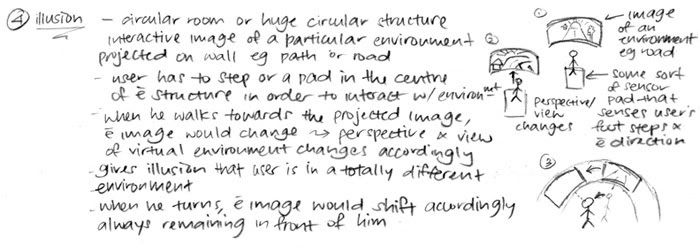
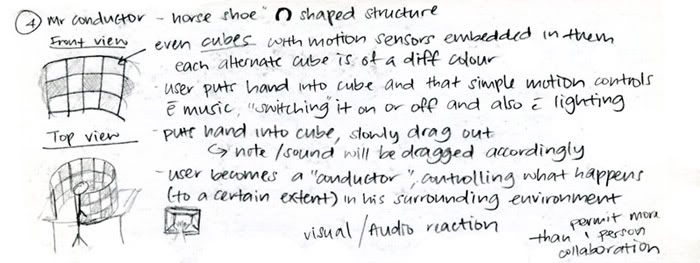
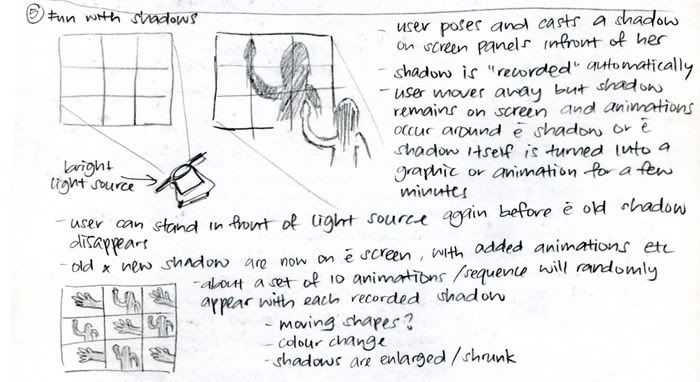




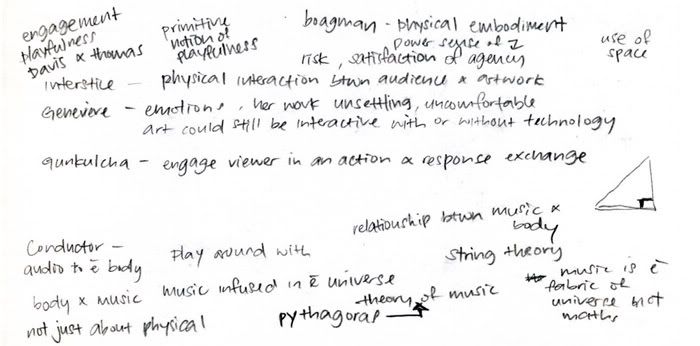
Wednesday, March 15, 2006
Links of interesting interactive art:
Tuesday, March 14, 2006
For the first project, I had to design two interative art installations and they had to be based on the same intent one of the 3 installations from ReActive I chose. So, to get my creative juices flowing, I thought that perhaps I could watch some movies that are based on human relationships with technology and interaction.
Movies on the list are:
- Bicentennial man (Seen it before but could watch again)
- Metropolis
- A.I.
- Ghost in the shell
Another way was to do research on existing Interactive art. Here are a number of books I borrowed of interactive art from the library:
- Prixars electronica : 2002 CyberArts by Leopoldseder, Hannes.
- Prixars electronica : 2003 CyberArts by Leopoldseder, Hannes.
- Interaction : artistic practice in the network, edited by Amy Scholder with Jordan Crandall.
- Creative code by John Maeda
- Art@science by Christa Sommerer and Laurent Mignonneau
- Virtual art : from illusion to immersion by Oliver Grau
- The inmates are running the asylum by Alan Cooper
- About face 2.0 : the essentials of interaction design by Alan Cooper and Robert Reimann.
In these books where a huge number of exisiting interactive design projects done by artists all over the world. I started looking at other people's designs and maybe I could think of ideas which were inspired by their work.
On the web I found examples of interaction design projects such as The Narcissist by Abigail Durrant. http://www.okeanos.org.uk/design/interaction/narc.html
Her work was based on works by performance artists in the 1970s who explored how the artist can act as a mirror for their audience. Her idea was to create "an interactive fable for a performance artist" and it looks like a two page book but the little screens on these pages act as a mirror. Vanity Mirror explores how technology, especially video technology, can accentuate our own narcissistic tendencies.

Wouldn't it be interesting if she had incorporated this idea into a story book. Maybe instead of reading the participants eye movement when grooming themselves, the book could project images with every page and a recording of a narrator telling a story. It could be turned into something like a hi tech children's audio book meets "mood ring". But the book projects the reader's emotions evoked by the story onto that image (e.g. sad part of the story, image would start to have blotches of blue emerging on the photo to indicate reader's sadness).
_______________________________________________________
The sound of music...
Being a huge music lover and ex musician, I know that I definately want a few designs to have something to do with sound or music.
Considerations:
- Allow people to create music (actually create a piece of music using installation?
- Or just noise? Action triggers sound?
Monday, March 13, 2006



ReActive was an interactive exhibition that featured the creative installations of 8 Australian artists, ranging from digital media to game consoles. It was held at Queensland University of Technology's The Block from the 23rd of February to 25th March 2006. These interactive art pieces were designed to instigate active participation and involvement among its audience but still "allowing the audience choice and partial physical control" (Jones & Thomas, 2006). Jones and Thomas (2006) explained that the aim of the exhibition was to "differentiate the exhibition from popular culture marketing of interactivity" and accentuate the interplay of works with the human body and mind, evoking various and sometimes, specific desired responses among its audience.
Saturday, March 11, 2006
Exercise:
Look for definitions of interaction design or interactivity
Reflections
He wrote heaps of articles relating back to Experience design and I foresee using quotations from him for the next few assignments. He has a book called Experience Design 1 in the library. I should borrow a copy and have a read.
- CD-ROM
- Interactive Television
- Reading a Book (it's not all in your head)
- Conversations
- Most Storytelling
- (Productivity) Applications
- Building and Decorating a House
- Games (of all kinds)
Friday, March 10, 2006
unit links
- KIB210 OLT
- Jane Turner - Interaction
- Jane Turner - Lecture 8
- Jane Turner - Lecture 9
- Jane Turner - Class notes
useful transits
- Jens Jensen - Interactivity
- Fundamentals of Interactivity
- Writing a critique
- Jonas Lowgren - Sketching Interaction Design
- How to create a clear project plan
- Prototyping
- Usability methods
- A Theory of Fun for Game Design" - What Games Aren't
- Flash kit
- Ljudo.com - Sound effects database
- Sounddogs - Sound effects database
- Critical Incident Technique Analysis
- Gamasutra
